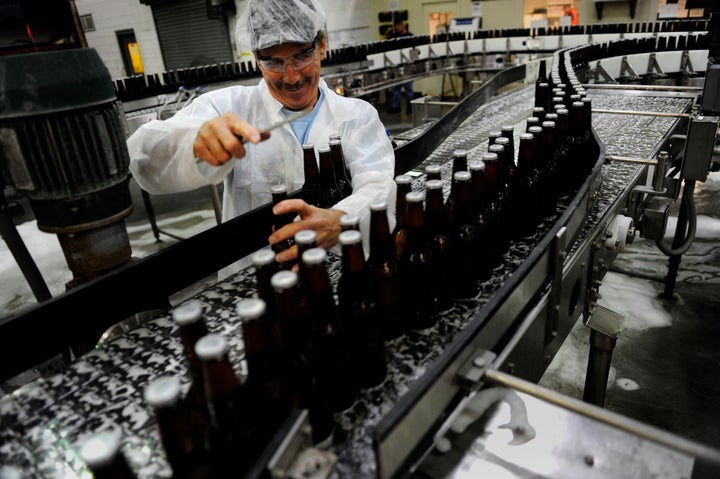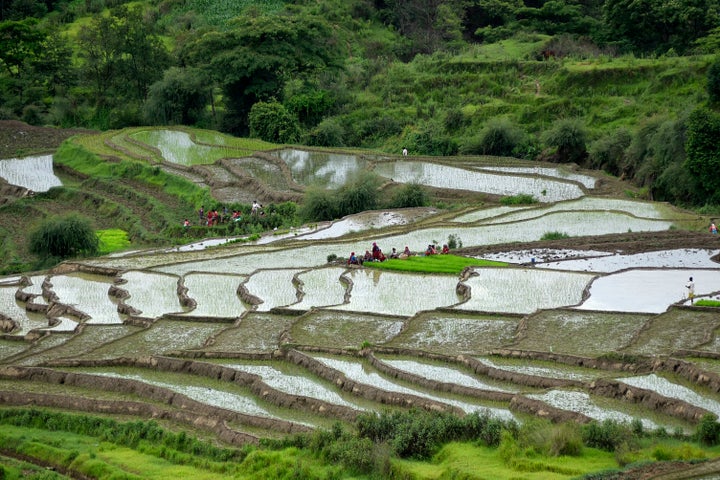Farmers are struggling to keep crops from withering on the vine thanks to a severe drought affecting more than 4.5% of the continental United States ― and turning on the sprinklers could make the problem worse.
“The shift toward more meat-based diets is becoming a major problem that puts pressure on water resources around the world,” said Heather Cooley, director of research at the Pacific Institute, a nonprofit focused on finding solutions to worldwide water challenges. “We need to think about how our diets impact water use.”
Some foods require a lot more water to produce than others and our appetites for them could exacerbate water issues. These foods are taxing an already scarce resource.
Almonds
The iconic California crop is a major water hog. It takes a whopping 3.2 gallons of water to grow a single almond and, with more than 1.3 million acres of almond orchards in California, it is the most extensively irrigated crop in the state. It takes almond trees an average of three years to start bearing fruit.
“Products that grow on trees require more water because they spend a lot of time not bearing any fruit, but must be kept alive to eventually bear fruits,” Anjuli Jain Figueroa, a postdoctoral scholar and water resources engineer, told HuffPost.
Beef
The amount of water cows drink (between 9 and 20 gallons per day) is a drop in the bucket compared with the 24 trillion gallons of water used annually to irrigate 56 million acres of cropland and pastureland nationwide, including land used to grow feed crops such as corn and wheat. The U.S. Geological Survey estimates that it takes 150 gallons of water to produce a quarter pound of hamburger. The biggest issue with beef, Figueroa noted, is scale.
“In the U.S., we devote a lot of land and resources to cattle,” she explained. “Reducing the consumption of beef is one thing you can do to reduce water use.”
Milk
Got milk? You need to have water first. The U.S. is home to more than 9.4 million dairy cattle, and it takes significant water resources to quench their thirst and irrigate the crops used to feed them, Figueroa said. More than 52 gallons of water are used to produce a single 8-ounce glass of milk.
Beer
Water is the main ingredient in beer and, thanks to our passion for cracking a cold one, the U.S. beer industry sold more than 2.8 billion cases of beer in 2018.

Brewers have started looking for opportunities to reduce their water footprint. In Oregon, Full Sail Brewing reduced its water consumption to less than 3 gallons of water to brew a gallon of beer (less than half of the industry average). In 2018, MillerCoors, makers of Coors Light and Miller 64, became the first brewer in the world to earn Alliance for Water Stewardship certification thanks to its efforts to reduce water consumption by 22%.
Coffee
It takes 35 gallons of water to grow enough coffee for a single cup of joe. Before the ripe cherries are harvested, coffee trees grow for an average of five years before reaching peak production. To complicate matters, drought has hit coffee-growing regions like Ethiopia, Uganda, Brazil and Vietnam, threatening crops; climate change is expected to reduce the amount of land suitable for growing coffee by 50% before 2050, according to a new report.
“It’s not just the water used to grow coffee that we need to think about,” Cooley added. “There is a lot of water embedded into the processing to take it from a raw bean to one that is washed and roasted.”
Chocolate
Before you bite into an 8-ounce chocolate bar, consider this: It takes more than 1,500 gallons of water to make the sweet treat. Cacao, like coffee, takes several years to mature and is often grown in West African countries like Ghana, Nigeria and Cameroon, where water resources are scarce. Much of the water is used during the production process, not in the finished product.
Rice
The staple crop is grown in water-logged paddies; 5 inches of water is pumped onto the paddies to keep the roots wet and the seeds are soaked again before being shipped. Conventional crops use up to 330 gallons of water to produce a single pound of rice, according to data from the Institute of Mechanical Engineers.

Newer management practices that include planting in raised beds instead of flooded paddies, increasing spacing and soil aeration, can reduce water needs between 30% and 50% while increasing yields. These practices could be especially important in countries like India, which has both a crippling water crisis and the largest cultivated rice areas in the world.
Poultry
Proteins like chicken and turkey have less of a water footprint than beef but, Figueroa said, “Most people are still surprised at how much water it takes to produce poultry.” Indeed, 500 gallons of water goes into producing a single pound of chicken. Most of the water resources are used to grow feed crops.
Sugar
The not-so-sweet news is that it takes a lot of water to grow sugar cane. The tropical grass, which grows in the tropics and subtropics, including Florida, Louisiana and Texas, goes through a post-harvest extraction process that turns it into refined sugar. Each heaping tablespoon of sugar takes more than 1 gallon of water to produce.
“Interestingly enough, the U.S. alternative of high fructose corn syrup, [made from corn], uses less water and is less expensive [but] monocropping with just corn has its own set of environmental impacts,” Figueroa said.
Of course, you don’t have to give up all of your favorite foods to make your diet more drought-friendly. Instead, Cooley suggested making informed choices to reduce your personal water footprint, adding, “The choices we make do matter.”
CORRECTION: A previous version of this piece incorrectly stated that 9,400 dairy cattle are in the U.S. There are more than 9.4 million.
